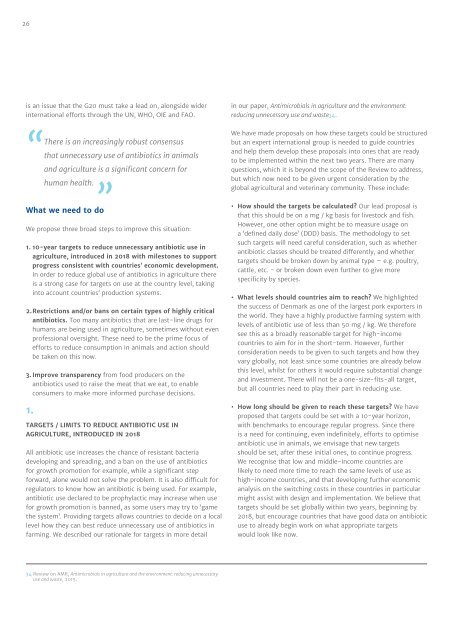TACKLING DRUG-RESISTANT INFECTIONS GLOBALLY FINAL REPORT AND RECOMMENDATIONS
qQvJ300ETXu
qQvJ300ETXu
You also want an ePaper? Increase the reach of your titles
YUMPU automatically turns print PDFs into web optimized ePapers that Google loves.
26<br />
is an issue that the G20 must take a lead on, alongside wider<br />
international efforts through the UN, WHO, OIE and FAO.<br />
in our paper, Antimicrobials in agriculture and the environment:<br />
reducing unnecessary use and waste34.<br />
“There is an increasingly robust consensus<br />
that unnecessary use of antibiotics in animals<br />
and agriculture is a significant concern for<br />
human health.<br />
”<br />
What we need to do<br />
We propose three broad steps to improve this situation:<br />
1. 10-year targets to reduce unnecessary antibiotic use in<br />
agriculture, introduced in 2018 with milestones to support<br />
progress consistent with countries’ economic development.<br />
In order to reduce global use of antibiotics in agriculture there<br />
is a strong case for targets on use at the country level, taking<br />
into account countries’ production systems.<br />
2. Restrictions and/or bans on certain types of highly critical<br />
antibiotics. Too many antibiotics that are last‐line drugs for<br />
humans are being used in agriculture, sometimes without even<br />
professional oversight. These need to be the prime focus of<br />
efforts to reduce consumption in animals and action should<br />
be taken on this now.<br />
3. Improve transparency from food producers on the<br />
antibiotics used to raise the meat that we eat, to enable<br />
consumers to make more informed purchase decisions.<br />
1.<br />
TARGETS / LIMITS TO REDUCE ANTIBIOTIC USE IN<br />
AGRICULTURE, INTRODUCED IN 2018<br />
All antibiotic use increases the chance of resistant bacteria<br />
developing and spreading, and a ban on the use of antibiotics<br />
for growth promotion for example, while a significant step<br />
forward, alone would not solve the problem. It is also difficult for<br />
regulators to know how an antibiotic is being used. For example,<br />
antibiotic use declared to be prophylactic may increase when use<br />
for growth promotion is banned, as some users may try to ‘game<br />
the system’. Providing targets allows countries to decide on a local<br />
level how they can best reduce unnecessary use of antibiotics in<br />
farming. We described our rationale for targets in more detail<br />
We have made proposals on how these targets could be structured<br />
but an expert international group is needed to guide countries<br />
and help them develop these proposals into ones that are ready<br />
to be implemented within the next two years. There are many<br />
questions, which it is beyond the scope of the Review to address,<br />
but which now need to be given urgent consideration by the<br />
global agricultural and veterinary community. These include:<br />
• How should the targets be calculated? Our lead proposal is<br />
that this should be on a mg / kg basis for livestock and fish.<br />
However, one other option might be to measure usage on<br />
a ‘defined daily dose’ (DDD) basis. The methodology to set<br />
such targets will need careful consideration, such as whether<br />
antibiotic classes should be treated differently, and whether<br />
targets should be broken down by animal type – e.g. poultry,<br />
cattle, etc. - or broken down even further to give more<br />
specificity by species.<br />
• What levels should countries aim to reach? We highlighted<br />
the success of Denmark as one of the largest pork exporters in<br />
the world. They have a highly productive farming system with<br />
levels of antibiotic use of less than 50 mg / kg. We therefore<br />
see this as a broadly reasonable target for high-income<br />
countries to aim for in the short-term. However, further<br />
consideration needs to be given to such targets and how they<br />
vary globally, not least since some countries are already below<br />
this level, whilst for others it would require substantial change<br />
and investment. There will not be a one-size-fits-all target,<br />
but all countries need to play their part in reducing use.<br />
• How long should be given to reach these targets? We have<br />
proposed that targets could be set with a 10-year horizon,<br />
with benchmarks to encourage regular progress. Since there<br />
is a need for continuing, even indefinitely, efforts to optimise<br />
antibiotic use in animals, we envisage that new targets<br />
should be set, after these initial ones, to continue progress.<br />
We recognise that low and middle-income countries are<br />
likely to need more time to reach the same levels of use as<br />
high-income countries, and that developing further economic<br />
analysis on the switching costs in these countries in particular<br />
might assist with design and implementation. We believe that<br />
targets should be set globally within two years, beginning by<br />
2018, but encourage countries that have good data on antibiotic<br />
use to already begin work on what appropriate targets<br />
would look like now.<br />
34 Review on AMR, Antimicrobials in agriculture and the environment: reducing unnecessary<br />
use and waste, 2015.


